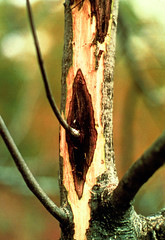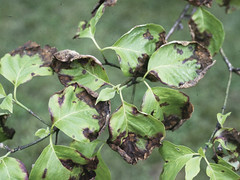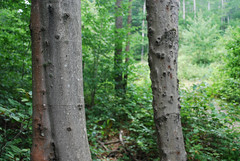Plant Diseases
Learn More
Other Websites
Bacteria and fungi (together with insects) are an important part of nature’s grand recycling program, converting dead plant and animal tissue to nutrients that can be used by living plants. But non-native bacterial, viral, and fungal pathogens have caused widespread diseases that have wiped out some plant species in Harpers Ferry National Historical Park (NHP) and threaten others.
Plant diseases typically infect some species and not others, which is why many diseases are called by the name of the plants they most profoundly impact.
Not all of the diseases listed below have reached Harpers Ferry NHP, but they are on course to do so! Diseases marked “potential” are threats to the park, but have not yet been confirmed there.
Explore this page:
Where Do Diseases Come From?
Many of the most threatening plant diseases spreading in the U.S. today were brought there on plants or wood products from around the world. (In the same way, some of the most threatening plant diseases spreading in Asia today were brought there from the U.S.!) Ecobit: Why Are Catastrophic Plant Diseases Usually Non-Native?
U.S. agencies are working to stop or slow their spread through the U.S., sometimes by quarantining plant products and soils from infected states or counties.
Plant Diseases
Chestnut Blight
 A pathogenic fungus causes chestnut blight, a lethal infection that has devastated the American chestnut tree (Castanea dentata) across its range in the eastern United States.
A pathogenic fungus causes chestnut blight, a lethal infection that has devastated the American chestnut tree (Castanea dentata) across its range in the eastern United States.
Photographer: Flickr user Vicky SommaIn the first several decades of the 1900s, an introduced fungus called chestnut blight (Cryphonectria parasitica) killed virtually all of the American chestnut trees in the forests of the eastern United States, including those in Harpers Ferry NHP. Some healthy trees were cut down to prevent the spread too.
Because chestnut was a major canopy tree, some of the forests at Harpers Ferry NHP looked vastly different in the 1800s.
The roots of the American chestnut continue to send up sprouts on some hillsides in the park.1 Unfortunately, it's likely that all of these sprouts will become infected and die back before reaching maturity. Look for a pencil-thick, spindly sapling (little to no branching), sometimes waist high or more. The leaves are similar to the chestnut oak, but with much more sharply pointed teeth. The sprout you see today probably comes from a seed that first germinated a century ago or more.
Butternut Canker
 Butternut canker is a lethal fungal infection of butternut trees (Juglans cinerea).
Butternut canker is a lethal fungal infection of butternut trees (Juglans cinerea).
Photographer: Mike Ostry, US Forest Service.All across the U.S., butternut canker (Sirococcus clavigignenti-juglandacearum) is making the butternut tree, which was never very common, especially hard to find.
Few butternut trees (also called white walnut) remain in Harpers Ferry NHP, and only in the West Virginia portion of the park.2
Dogwood Anthracnose
 Dogwood anthracnose (Discula destructiva) leaf blotch.
Dogwood anthracnose (Discula destructiva) leaf blotch.
Photographer: Mary Ann Hansen, Virginia Polytechnic Institute and State University, Bugwood.org. Dogwood anthracnose (Discula destructiva) has been attacking flowering dogwoods in the U.S. since the mid-1970s.
Dutch Elm Disease (potential)
 Evidence of Dutch elm disease (Ophiostoma ulmi) on an American elm (Ulmus americana).
Evidence of Dutch elm disease (Ophiostoma ulmi) on an American elm (Ulmus americana).
Photographer: Joseph O’ Brien, USDA Forest Service, Bugwood.org. Dutch elm disease (Ophistoma ulmi) can infect all of our native elm species, and infected trees usually die.
Elm Yellows / Elm Phloem Necrosis (potential)
 Elm yellows or elm phloem necrosis is a lethal disease affecting elm trees (Ulmus spp.) in the eastern U.S. and Canada.
Elm yellows or elm phloem necrosis is a lethal disease affecting elm trees (Ulmus spp.) in the eastern U.S. and Canada.
Photographer: Flickr user William Yurasko.As if one elm disease weren’t enough, there is another, newer threat. Elm yellows is caused by a bacteria that is spread by an insect called the leaf hopper.
Beech Bark Disease (potential)
 Beech bark disease causes lesions in the bark of American beech trees (Fagus grandifolia).
Beech bark disease causes lesions in the bark of American beech trees (Fagus grandifolia).
Photographer: Flickr user Eli Sagor.Beech bark disease can kill large American beech trees after a non-native beech scale beetle (Cryptococcus fagisuga) has created tiny holes in the bark, allowing spores of a non-native fungus (Neonectria faginata or Neonectria ditissima) to enter. It has been spreading throughout the eastern United States, with isolated infestations found in Virginia, West Virginia, and Maryland forests.3
Sudden Oak Death (potential)
A relative newcomer to the park’s list of management concerns is a disease called sudden oak death (Phytophthora ramorum).
You Can Make a Difference!
The National Park Service keeps a vigilant watch, and asks visitors to do the same, so that suspected disease outbreaks can be identified early and curbed where possible. Ecobit: An Extra Set of Eyes By being observant when you're visiting Harpers Ferry NHP and sharing what you see with park staff, you can help keep its natural communities healthy. Thank you!
- 1. . 2014. NCRN Resource Brief: American Chestnut Inventory, Harpers Ferry NHP.
- 2. . 2013. Harpers Ferry National Historical Park Natural Resource Condition Assessment.
- 3. . 2008. Beech Bark Disease. Accessed 2018


